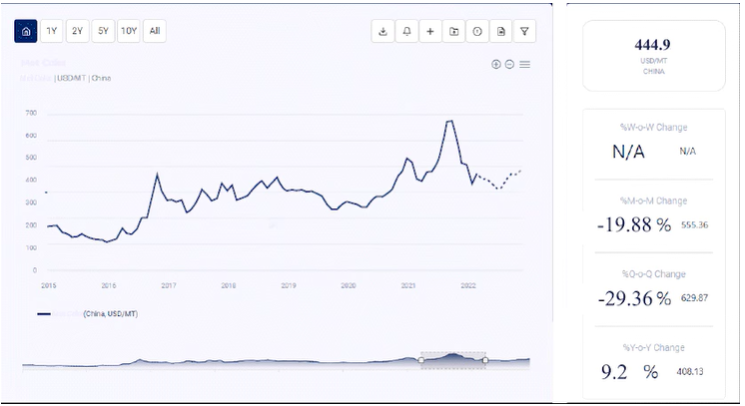Citric acid, a versatile organic acid widely used in the food and beverage, pharmaceutical, and cosmetic industries, plays a crucial role as an acidulant, flavor enhancer, preservative, and chelating agent. Understanding the price trends of citric acid is essential for businesses to anticipate costs, plan budgets, and make informed purchasing decisions. In this article, we explore the factors influencing citric acid price trend and the dynamics shaping the market.
Factors Influencing Citric Acid Price Trends:
-
Raw Material Costs: The primary raw materials for citric acid production are sugar and molasses, which serve as feedstocks for fermentation by microorganisms such as Aspergillus niger. Fluctuations in the prices of sugar and molasses, influenced by factors such as crop yields, weather conditions, and market demand, directly impact citric acid production costs. Changes in raw material prices can significantly affect the overall cost of citric acid production and subsequently influence pricing trends.
-
Production Capacity and Demand: The balance between citric acid production capacity and market demand plays a crucial role in pricing trends. When production capacity exceeds demand, oversupply may lead to downward pressure on prices as manufacturers compete for market share. Conversely, when demand outstrips production capacity, shortages may occur, driving prices higher due to increased competition for available supply.
-
Energy Costs: Energy-intensive manufacturing processes, including fermentation, purification, and drying, contribute to citric acid production costs. Fluctuations in energy prices, such as electricity and fuel costs, impact overall production expenses. Changes in energy prices can directly affect the cost of citric acid production and subsequently influence pricing trends.
-
Market Competition: The presence of multiple citric acid producers and suppliers creates competitive pressures that influence pricing dynamics. Intense competition among manufacturers may lead to price competition or strategic pricing decisions to capture market share. Additionally, technological advancements, process innovations, and cost-saving measures adopted by competitors can impact pricing trends within the citric acid market.
-
End-User Industries: Demand for citric acid is driven by various industries, including food and beverage, pharmaceuticals, cosmetics, and household products. Market dynamics within these industries, including changes in consumer preferences, product innovation, and regulatory requirements, can influence citric acid demand and pricing trends.
Enquire For Regular Prices: https://www.procurementresource.com/resource-center/citric-acid-price-trends/pricerequest
Market Dynamics and Outlook:
-
Food and Beverage Industry Trends: The food and beverage industry is the largest consumer of citric acid, using it as a flavoring agent, preservative, and acidulant in a wide range of products, including beverages, confectionery, sauces, and processed foods. Market trends in the food and beverage sector, such as shifts in consumer preferences towards natural ingredients, clean-label products, and healthier alternatives, influence citric acid demand and pricing trends.
-
Pharmaceutical and Cosmetics Applications: Citric acid finds applications in the pharmaceutical and cosmetics industries as an excipient, pH adjuster, and chelating agent in formulations such as tablets, creams, and lotions. Demand for citric acid in pharmaceutical and cosmetic applications is influenced by product innovation, regulatory requirements, and consumer trends in personal care and wellness products.
-
Global Trade Dynamics: Citric acid is a globally traded commodity, with major producing countries including China, the United States, and India. Trade dynamics, including tariffs, trade agreements, and geopolitical factors, can impact citric acid prices by affecting supply chain logistics, import/export volumes, and market competition.
-
Regulatory Environment: Regulatory standards and quality requirements, such as food safety regulations, pharmacopeial standards, and cosmetic ingredient regulations, impact citric acid production costs and pricing trends. Compliance with regulatory requirements, including product certifications, quality control measures, and safety assessments, may influence production costs and pricing dynamics.
-
Sustainability Initiatives: Increasing consumer awareness of environmental sustainability and corporate responsibility is driving demand for sustainably sourced and produced citric acid. Manufacturers are adopting sustainable practices, such as eco-friendly production methods, renewable energy utilization, and waste reduction initiatives, to meet consumer expectations and regulatory mandates, which can impact pricing trends in the long term.
Conclusion
In conclusion, the pricing trends of citric acid are influenced by a combination of factors, including raw material costs, production capacity, demand dynamics, energy prices, market competition, end-user industries, global trade dynamics, regulatory environment, and sustainability initiatives. Understanding these factors and their interplay is essential for businesses to navigate the citric acid market effectively, anticipate pricing fluctuations, and make informed decisions regarding procurement, production, and pricing strategies. Moreover, staying abreast of evolving market dynamics, industry trends, and regulatory developments is critical for businesses to adapt to changing market conditions and maintain competitiveness in the citric acid industry.
